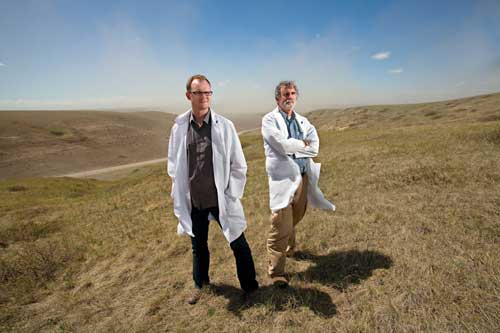Every time you turn your head one way or another, the nerve cells in your brain, called neurons, keep you oriented in space.
Scientists have clues about how this brain-based compass works. But the nuts and bolts of the system, and its possible role in the way memories form and fade, are still a puzzle that researchers such as Dr. Ben Clark (BSc '05), are trying to solve.
In particular, the University of Lethbridge postdoctoral researcher and Alberta Innovates -- Health Solutions postgraduate fellowship recipient is working to understand if and how the brain circuits that deal with directional information may also impact both memory formation and dementia.
Dauphin, Man.-born Clark began looking at the brain's direction-sensing systems as a graduate student in Jeffrey Taube's lab at Dartmouth College in New Hampshire.
Now back in Canada and working as a postdoctoral researcher in Dr. Bruce McNaughton's Lethbridge Brain Dynamics lab at the Canadian Centre for Behavioural Neuroscience (CCBN), Clark, who also holds an honours bachelor of science degree in neuroscience from the University of Lethbridge (2005), is interested in figuring out whether the same sorts of brain maps are also used to commit new information or situations to memory.
If so, he and others speculate that the breakdown of these maps could also contribute to memory-related conditions, such as dementia and Alzheimer's disease.

The potential links between these two neural functions are complex, Clark explains, but the idea is that the memories rely, at least in part, on the brain's ability to determine direction.
In animals, spatial mapping seems to centre on sets of so-called 'head direction' neurons, brain cells that are electrically active when an animal's head is pointing in one direction but not another -- and 'grid cells,' which contribute to a broader brain-based map of the surrounding environment.
Together, this brain cell activity produces something of an internal compass for understanding our place in the world around us.
The neurons communicating these direction-dependent signals are spread throughout the brain's temporal lobes, which are found just behind each ear, Clark explains.
But past studies suggest that their signals come together in a part of that brain region known as the entorhinal cortex, which also deals with information the brain uses to recognize objects.
There are hints that the entorhinal cortex is among the first parts of the brain to show changes during Alzheimer's disease too, which is consistent with the notion that object recognition and spatial cues may be crucial to memory.
To explore these potential connections, Clark plans to follow the activity of grid cells and head direction neurons, those direction-sensitive brain cells, using a system that lets him physically see neurons' activation.
That's possible because when neurons fire they turn on specific genes. And with a bit of genetic engineering, researchers can couple the gene activation to the production of proteins that glows fluorescent green or red under certain wavelengths of light.

For the current project, Clark and his collaborators will use two such genes as a means of tracking spatial mapping and head direction neurons in rats as they encounter new objects or spatial situations, for instance.
With slightly different experimental techniques in other experiments, they also plan to follow the neurons that stretch from the entorhinal cortex into other memory-related parts of the brain.
The researchers have done preliminary experiments to ensure that their fluorescent gene scheme will be able to measure neuron activity. Next, they're gearing up to use these tools to test normal rats as well as rat models of disease that show some of the symptoms associated with Alzheimer's disease.
Over the longer term, Clark explains, researchers intend to create functional maps of the these animal brains during disease, looking not only at the entorhinal cortex but also at other brain areas that are thought to contribute to dementia and Alzheimer's disease.
Story by Andrea Anderson, photos by Trudie Lee. Re-printed with permission from Alberta Innovates -- Health Solutions. This story appeared in the most recent issue of Health Solutions magazine.
